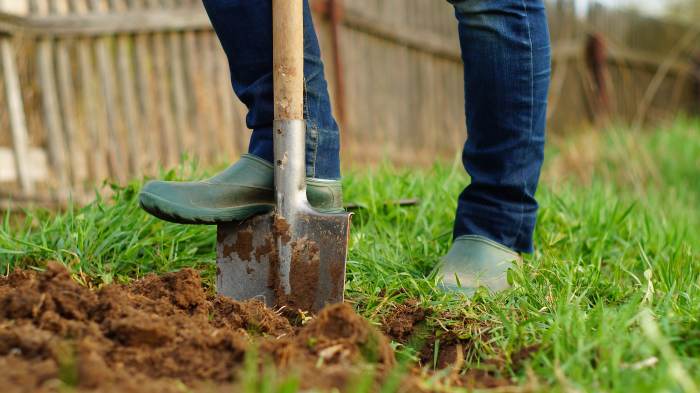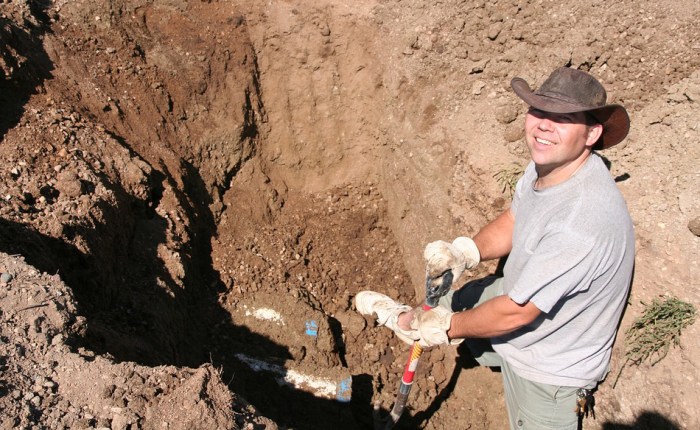Name something people dig up – Unearthing the hidden wonders beneath our feet, “The Earthly Delights of Digging” embarks on an enthralling journey into the captivating world of archaeology, paleontology, gardening, treasure hunting, construction, and more. From excavating ancient artifacts that whisper tales of bygone eras to uncovering fossils that unlock the secrets of prehistoric life, this exploration delves into the intriguing practices that involve digging up the earth’s buried treasures.
As we delve deeper into the fascinating realm of excavation, we uncover the historical significance of artifacts that shed light on our past, marvel at the intricate techniques used to extract and analyze fossils, and discover the profound impact of digging in soil for the flourishing of plant life.
Whether embarking on treasure hunts with metal detectors or witnessing the transformative power of excavation in construction projects, this exploration unveils the diverse and captivating ways in which people engage with the act of digging up the earth.
Archaeological Discoveries

Archaeological discoveries play a pivotal role in unraveling the mysteries of our past. They provide tangible evidence of human history, offering insights into civilizations, cultures, and lifestyles that have long vanished.
The excavation and preservation of ancient findings require meticulous methods and specialized techniques. Archaeologists carefully remove soil and debris, employing tools such as brushes and trowels, to expose artifacts and structures without damaging them. Advanced imaging techniques, like ground-penetrating radar and magnetometry, assist in locating buried remains and mapping archaeological sites.
One thing that people often dig up is plants. If you’re looking for a great place to buy plants, Garden Depot is a great option. They have a wide variety of plants to choose from, and their prices are very reasonable.
So if you’re looking for a new plant to add to your garden, be sure to check out Garden Depot.
Famous Archaeological Discoveries
Numerous archaeological discoveries have revolutionized our understanding of history:
- Pompeii:The Roman city preserved by the eruption of Mount Vesuvius in 79 AD, offering a glimpse into everyday life and architecture during the Roman Empire.
- Terracotta Army:The vast collection of ceramic warriors and horses found in the tomb of the first Chinese emperor, Qin Shi Huang, showcasing the sophistication of ancient Chinese craftsmanship.
- Dead Sea Scrolls:Ancient manuscripts discovered in caves near the Dead Sea, providing valuable insights into Jewish history and the origins of Christianity.
- Lascaux Caves:The prehistoric caves in France adorned with stunning cave paintings, offering a glimpse into the artistic and spiritual beliefs of early humans.
Fossils and Paleontology

Fossils, preserved remnants or traces of ancient organisms, offer invaluable insights into the history of life on Earth. Paleontologists study fossils to reconstruct past environments, understand evolutionary relationships, and uncover the diversity of life that existed millions of years ago.
Fossil Formation
Fossils form when organisms or their parts are buried and preserved in sediments over long geological timescales. Common processes include:
- Permineralization:Minerals replace organic material, preserving the organism’s shape and structure.
- Replacement:Original organic material is dissolved and replaced by minerals, leaving a mold of the organism.
- Carbonization:Organic material is converted into a thin layer of carbon, preserving the organism’s Artikel.
Types of Fossils
Paleontologists classify fossils based on their composition and preservation:
- Body fossils:Preserved remains of the organism itself, such as bones, teeth, shells, or leaves.
- Trace fossils:Indirect evidence of an organism’s presence, such as footprints, burrows, or nests.
- Chemical fossils:Preserved organic molecules, such as lipids or amino acids, that can provide insights into an organism’s biochemistry.
Extraction and Analysis
Extracting and analyzing fossils requires specialized techniques:
- Excavation:Fossils are carefully excavated from the ground using brushes and small tools.
- Preparation:Fossils are cleaned, repaired, and stabilized to preserve their delicate structures.
- Imaging:Advanced imaging techniques, such as X-rays and CT scans, reveal internal structures and hidden details.
Significant Fossil Discoveries
Fossil discoveries have revolutionized our understanding of prehistoric life:
- Lucy (Australopithecus afarensis): A 3.2 million-year-old hominin fossil that provided evidence of bipedalism.
- Tiktaalik roseae:A 375 million-year-old transitional fossil that shed light on the evolution of fish to land animals.
- Tyrannosaurus rex:One of the largest carnivorous dinosaurs ever discovered, providing insights into the apex predators of the Cretaceous period.
Gardening and Horticulture: Name Something People Dig Up

Digging in soil is a fundamental aspect of gardening and horticulture, providing numerous benefits for plant growth and health. It improves soil aeration, drainage, and nutrient availability, creating an optimal environment for roots to thrive.
Types of Digging Tools and Techniques
Various digging tools are employed in gardening, each suited to specific tasks and soil conditions. Common tools include spades, shovels, forks, and tillers.
- Spadesare ideal for digging deep holes and trenches, with their flat blades providing a clean cut.
- Shovelsare versatile tools used for moving soil, with their curved blades allowing for efficient scooping.
- Forksare designed to loosen and aerate soil, preventing compaction and promoting root penetration.
- Tillersare power tools that break up soil and prepare large areas for planting, saving time and effort.
Common Plants that Require Digging for Cultivation, Name something people dig up
Many plants require digging for proper cultivation, including:
| Plant | Digging Depth |
|---|---|
| Trees | 1-2 feet |
| Shrubs | 1-1.5 feet |
| Perennials | 6-12 inches |
| Annuals | 4-8 inches |
| Vegetables | 6-12 inches |
Treasure Hunting and Metal Detecting

Treasure hunting and metal detecting are captivating activities that combine the thrill of discovery with the allure of uncovering hidden treasures. These pursuits employ various methods and equipment to locate buried objects, ranging from ancient artifacts to valuable metals.
Methods and Equipment
Treasure hunters and metal detectorists utilize a range of techniques to pinpoint their targets. These include:
- Ground-Penetrating Radar (GPR):Emits electromagnetic waves that penetrate the ground, creating images of buried objects.
- Magnetometers:Detect magnetic disturbances caused by ferrous metals, indicating the presence of buried treasures.
- Metal Detectors:Emit electromagnetic fields that generate audible signals when they encounter metal objects.
Notable Treasure Discoveries
Throughout history, treasure hunting has yielded remarkable discoveries, such as:
- Tutankhamun’s Tomb:Discovered by Howard Carter in 1922, this Egyptian pharaoh’s tomb contained an astonishing collection of artifacts.
- Antikythera Mechanism:A 2,000-year-old Greek astronomical computer, discovered by sponge divers in 1901.
- Gold Rush Era:The discovery of gold in California in 1848 sparked a mass migration of prospectors, leading to the establishment of many Western towns.
Legal and Ethical Considerations
Treasure hunting and metal detecting are often subject to legal and ethical regulations. These may include:
- Trespassing:Permission from landowners is required before searching on private property.
- Archaeological Significance:Some discoveries may have historical or archaeological importance, requiring professional excavation and preservation.
- Environmental Impact:Digging and excavation can potentially damage the environment, requiring responsible practices.
Construction and Infrastructure
Excavation plays a vital role in construction projects, as it involves digging and removing soil or rock to create space for foundations, utilities, and other infrastructure. Before excavation begins, engineers and contractors conduct thorough site assessments to determine the soil conditions, groundwater levels, and any potential hazards.
They also develop detailed excavation plans that Artikel the depth, width, and slope of the excavation, as well as the methods to be used.
Safety Measures and Engineering Principles
Safety is paramount during excavation, and various measures are implemented to protect workers and the surrounding environment. These include:
- Shoring and bracing to prevent cave-ins and landslides
- Dewatering systems to control groundwater levels
- Proper ventilation to prevent the accumulation of hazardous gases
- Monitoring systems to detect any changes in soil conditions or structural stability
Engineering principles guide excavation techniques to ensure the stability of the excavated area and the surrounding structures. These principles include:
- Soil mechanics to understand the behavior of soil under different conditions
- Geotechnical engineering to design excavation slopes and support systems
- Structural engineering to ensure the integrity of foundations and other structures
Innovative Excavation Techniques
Modern construction projects employ innovative excavation techniques to improve efficiency, safety, and sustainability. Some of these techniques include:
Trenchless technology
This involves installing utilities and pipelines underground without the need for open trenches, minimizing surface disruption and environmental impact.
Vacuum excavation
This technique uses a vacuum to remove soil and debris, reducing dust and noise pollution and improving safety for workers.
Hydro-excavation
This method uses high-pressure water jets to loosen and remove soil, making it suitable for delicate excavations near existing structures.
Top FAQs
What are the ethical considerations involved in treasure hunting?
Treasure hunting can raise ethical concerns regarding the ownership and preservation of artifacts. It is crucial to respect the cultural and historical significance of discovered objects and to ensure that they are handled and preserved responsibly.
What safety measures should be taken when digging for construction projects?
Safety is paramount in excavation for construction. Proper engineering assessments, protective equipment, and adherence to safety protocols are essential to minimize risks and ensure the well-being of workers.
How can digging in soil benefit plant growth?
Digging in soil aerates it, improving drainage and allowing roots to penetrate deeper. This enhanced root growth leads to better nutrient uptake, resulting in healthier and more vigorous plants.
